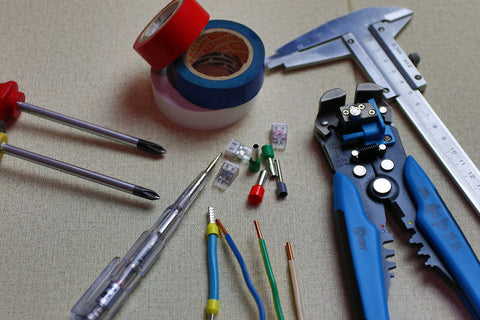
Alarm.com Video - Is it a good choice for you?
18 Jan 2024
Low-Cost Ways to Make Your Home More Secure
26 Dec 2019
24 May 2018
If you’re thinking about upgrading your home’s electronic home security system, you probably know that going from a hardwired to a wireless security system can be a challenge. The same goes for families who move and take their wireless security devices with them, only to find that their new home already has hardwired security zones. Using the pre-installed sensors together with their wireless sensors could make sense, but how would they make that happen?
Migrating any existing home protection to a wireless Honeywell security system like the Lynx Touch system can cost you a lot in labor and new equipment. In both situations, you may consider just replacing the old sensors or buying new transmitters. Aside from purchasing new accessories, that means having to hire and pay security-system experts to work on your home. But with the Honeywell security expansion modules, homeowners have a simpler and lower-cost alternative.
Some Hard Truths About Hardwired Connections

Photo Courtesy of pashminu via Pixabay
Traditionally, hardwired security setups have been a good option for homeowners. They offer a lot of flexibility because they connect with switches and sensors that have two- or four-conductor wiring, which are typically generic and can connect to nearly any brand. What’s more, the components of hardwired security systems, on the whole, are cheaper compared than wireless security devices.
And unless they get worn down over time or sabotaged, connections to hardwired zones — devices and sensors that are physically connected to a control panel — send very clear signals, which is a particular benefit for setups that include cameras.
Wireless zones, on the other hand while generally very reliable can sometimes have issues with certain environment such as penetrating steel walls. Wireless devices can also transmit signals only within a limited range, which is why security professionals tend to recommend physically connected systems for large residences.
Why Go Wireless

Photo Courtesy of rawpixel via Pixabay
But over time, homeowners realized the benefits of wireless security systems. They’re easier and cheaper to install, with average installation costs for hardwired systems falling between $800 and $1600. They’re also great for on-the-go monitoring: many wireless security systems in the market can allow you to check for security updates on your mobile phone. And with more families setting up smart homes, the appeal of smart security systems is also on the rise.
Wireless systems are also becoming more reliable. Many wireless setups have battery-powered devices and, like most other alarm systems, can be fitted with backup power supplies, which means they’re less vulnerable to power outages or electrical-system sabotage, not to mention the possibility of pests chewing through the wires. And new systems that use Z-Wave communication are able to send integrate home automation wirelessly as well.
The lack of physical wiring also makes wireless systems more adaptable. Changing your home security setup — something you might need to do when renovating, for example — is easier when sensors and detectors aren’t fixed in place with wires. Expanding your security setup with new sensors and detectors is also relatively simple. And should you decide to move, you can pack up your wireless security system and reinstall it in your new home.
For all these reasons, more families are considering retrofitting their hardwired security systems to wireless ones. Typically, that would be a project that requires a lot of expense, both in terms of labor and equipment. But with the Honeywell 5800C2W security hardwired to wireless converter, homeowners can easily connect their existing hardwired zones to a Lynx wireless security control panel. It’s basically a wireless hub — you can plug wired sensors into the unit, and it will convert them to Honeywell’s 5800 Series wireless technology.
The First Steps: Mounting and Wiring

Photo Courtesy of Sid74 via Pixabay
So how do you convert hardwired security to wireless using the Honeywell 5800C2W? First, decide on the location and position where you’ll mount the Honeywell wireless security converter. For most installations, you’ll want to place it near the existing control panel; you can put it elsewhere, but you’ll most likely have to do additional wiring work to connect the hardwired zones to the converter. Note that you shouldn’t mount the Honeywell 5800C2W within the existing control panel or any other metal enclosure, since that’ll block the wireless signals that it sends out.
Once you’ve found a good spot — one with adequate signal strength and a nearby outlet to plug the converter into — mount the “tamper magnet” to the Honeywell 5800C2W enclosure cover, then affix the unit to the wall using the supplied double-sided tape (and screws, if you like).
At this point, you should be able to reconnect the hardwired devices, moving the connections from the control panel to the Honeywell 5800C2W converter. At the bottom of the unit, you’ll see a row of contact terminals where you should connect the wires. However, some of those are actually grounding terminals, so keep that in mind when rewiring the security devices. Also, note that all zones connected to the converter must have EOL (end-of-line) resistors with values from 1k to 10k ohms.
There’s a limit to the devices you can connect to the 5800C2W. It can accept up to nine hardwired zones only, which include glassbreak detectors, contacts, passive infrared sensors (PIRs), and other 12-volt sensors. Also, it’s not to be used with fire or heat sensors; any existing smoke, heat or CO detectors should ideally be replaced with new Honeywell 5800 Series detectors.
Finishing Up: Calibration and Enrollment

Photo Courtesy of geralt via Pixabay
After wiring all the devices you need, plug the power transformer into an unswitched outlet and secure with a screw. If you placed the unit next to the existing control panel, you may have a backup battery inside the control panel and connect it to the converter. A lot of hardwired systems already include a battery, but in some cases, they may need to be replaced. In the case of the 5800C2W, you’ll need a 12-volt, 4Ah battery. During the installation, make sure to position the integral battery cable fuse inside the control panel enclosure.
With the zones wired in and the Honeywell security converter powered up, you can start the calibration process to let the 5800C3W learn which zones will be active and what value EOL resistors are used. During calibration, unused zones that are open will not be recognized and reported; in other words, the system will not count any terminals that don’t have security devices connected to them.
Before the calibration, make sure all zones are connected and not tripped. Then look for the top left button on the 5800C2W — it should be labelled SW2 — and click it. You should see LED indicator #1 flash red for half a second, then turn steady green. The green color means the 5800C2W has been calibrated and is ready to be enrolled in the control panel for your wireless security system.
The process for enrollment will differ depending on the Honeywell security system you’re using with the security converter: that would be either the Lynx Touch, which provides interconnected home and business functionality, or the Lynx Plus, which is for traditional wireless security. But in general, you may enroll the different zones of the Honeywell 5800C2W in “Zone Programming” mode, which involves tripping each zone. Alternatively, you can manually program the 5800C2W module, followed by each of its zones, into the control panel. Consult the guide for the touch screen panel you’ll be using.
Wireless security devices are improving by leaps and bounds. Aside from improved ability to connect remotely with other devices, they offer users increased options for monitoring, control, and smart-home integration. That means more homeowners should consider upgrading from their existing hardwired setup — but that doesn’t mean having to give it all up right away. As wireless systems become increasingly preferable, smart and budget-conscious homeowners can turn to Honeywell for easier hardwired security conversion.
18 Jan 2024
26 Dec 2019